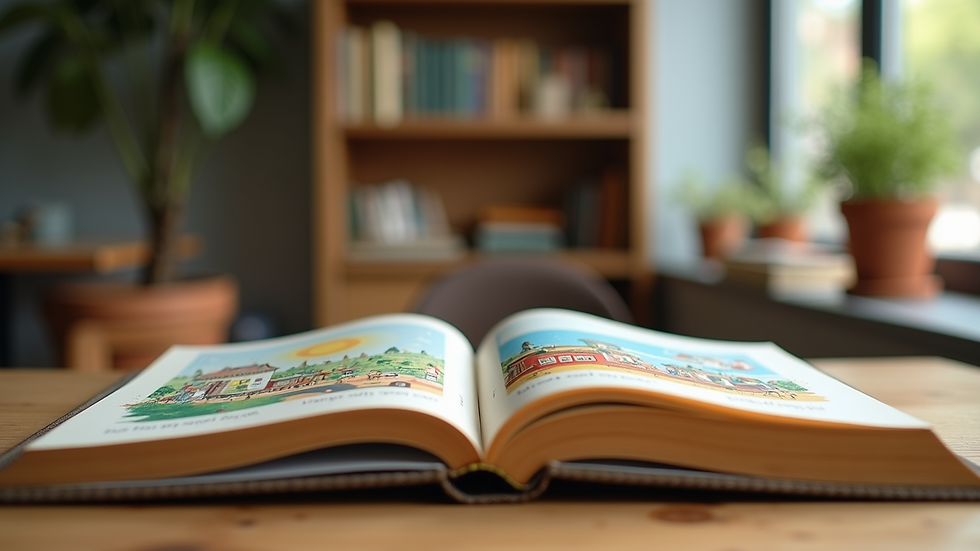Simple Tools to Make Learning Fun for Kindergarteners
- Shivangi Dubey
- Aug 4, 2025
- 4 min read
Learning in kindergarten is a crucial step in a child's development. At this stage, children are curious and eager to explore the world around them. Using simple learning tools can transform education into an exciting adventure. These tools help children grasp basic concepts while keeping them engaged and motivated. This article explores practical and easy-to-use learning tools that make learning fun for kindergarteners.
Why Simple Learning Tools Matter for Kindergarteners
Kindergarteners have short attention spans and learn best through play and hands-on activities. Simple learning tools cater to their developmental needs by making abstract concepts tangible. These tools encourage creativity, problem-solving, and social interaction. For example, colorful blocks can teach counting and shapes, while storybooks develop language skills.
Using simple tools also reduces frustration. When children understand what they are learning, they feel confident and motivated to continue. This positive experience builds a strong foundation for future learning.
Benefits of Using Simple Learning Tools
Enhances engagement: Bright colors and interactive elements capture attention.
Supports different learning styles: Visual, auditory, and kinesthetic learners all benefit.
Encourages independence: Children can explore and learn at their own pace.
Builds fine motor skills: Manipulating objects improves hand-eye coordination.
Promotes social skills: Group activities foster cooperation and communication.

Top Simple Learning Tools to Use in Kindergarten
Choosing the right tools can make a big difference. Here are some of the best simple learning tools that are easy to use and highly effective.
1. Flashcards
Flashcards are a classic tool for teaching letters, numbers, shapes, and vocabulary. They are portable, inexpensive, and versatile. You can create your own or find printable sets online. Flashcards encourage quick recall and can be used in games like matching or memory.
How to use flashcards effectively:
Show one card at a time and say the word or number aloud.
Ask the child to repeat or identify the card.
Mix cards to create fun quizzes or challenges.
Use flashcards to tell simple stories or sequences.
2. Magnetic Letters and Numbers
Magnetic letters and numbers stick to metal surfaces like refrigerators or magnetic boards. They allow children to practice spelling, counting, and simple math in a tactile way. Kids enjoy arranging and rearranging the magnets to form words or solve problems.
Tips for magnetic learning:
Encourage children to spell their names or favorite words.
Use magnets to demonstrate addition and subtraction.
Create simple puzzles or patterns to follow.
Combine with a whiteboard for drawing and writing.
3. Interactive Storybooks
Storybooks with interactive elements such as flaps, textures, or sounds engage multiple senses. These books make reading a dynamic experience and help develop language skills. Choose books with simple sentences and colorful illustrations.
Ways to enhance storytime:
Ask questions about the pictures and story.
Encourage children to predict what happens next.
Use props or puppets to act out the story.
Let children turn pages and explore the book independently.

4. Building Blocks and Puzzles
Building blocks and puzzles develop spatial awareness, problem-solving, and fine motor skills. They also promote creativity as children design structures or complete pictures. Choose blocks of different shapes and sizes, and puzzles with large pieces.
Suggestions for block and puzzle play:
Challenge children to build towers or specific shapes.
Use puzzles to teach shapes, animals, or numbers.
Encourage teamwork by working on puzzles together.
Rotate toys regularly to maintain interest.
5. Educational Apps and Videos
Technology can be a helpful supplement when used in moderation. Educational apps and videos designed for kindergarteners offer interactive lessons on letters, numbers, and more. Look for apps with simple navigation and positive reinforcement.
Guidelines for screen time:
Limit sessions to 15-20 minutes.
Choose content that aligns with learning goals.
Participate with your child to guide and discuss.
Balance screen time with hands-on activities.
How to Incorporate Printable Resources in Learning
Printable resources are a fantastic way to provide structured learning activities. They can be customized to suit different skill levels and interests. For example, worksheets for tracing letters, counting exercises, or coloring pages help reinforce concepts.
One excellent resource is the kindergarten printable collection, which offers free mini magazines and activity sheets. These printables are designed to be fun and educational, making them perfect for home or classroom use.
Tips for using printables effectively:
Set aside a quiet space for focused activities.
Use colorful crayons or markers to make it enjoyable.
Combine printables with physical activities like cutting or pasting.
Praise effort and celebrate completed work.

Encouraging a Love for Learning Through Play
The key to successful learning at this age is to make it enjoyable. Play-based learning helps children absorb information naturally. Simple learning tools should be integrated into daily routines and free play.
Ideas to promote playful learning:
Create themed learning stations (e.g., a reading corner, a math table).
Use songs and rhymes to teach concepts.
Incorporate outdoor activities like nature walks and scavenger hunts.
Allow children to choose activities to foster autonomy.
By combining simple tools with playful methods, children develop a positive attitude toward learning that lasts a lifetime.
Making Learning a Family Affair
Learning does not have to be confined to school or formal settings. Families can play a vital role by using simple learning tools at home. This involvement strengthens bonds and reinforces skills.
Ways families can support learning:
Read together daily and discuss stories.
Play educational games as a group.
Use everyday moments like cooking or shopping to teach math and language.
Celebrate milestones and progress with encouragement.
Simple tools like flashcards, magnetic letters, and printables can be easily incorporated into family activities, making learning a shared joy.
Using simple learning tools is a powerful way to make education fun and effective for kindergarteners. These tools support development, build confidence, and inspire curiosity. By choosing the right resources and approaches, learning becomes an exciting journey that children look forward to every day.




Comments